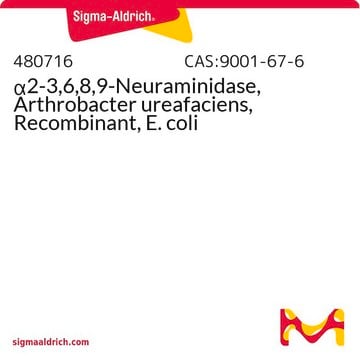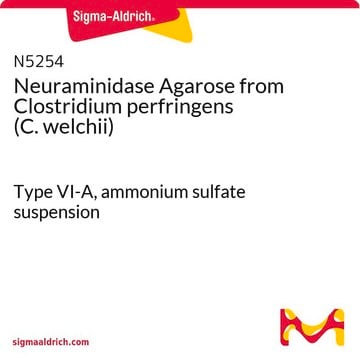10269611001
Roche
Neuraminidase (Sialidase)
from Arthrobacter ureafaciens
Synonym(s):
PCR, taq
Sign Into View Organizational & Contract Pricing
All Photos(1)
About This Item
Recommended Products
biological source
bacterial (Arthrobacter ureafaciens)
Quality Level
form
solution
specific activity
~25 units/mg protein
packaging
pkg of 1 U (100 μl)
manufacturer/tradename
Roche
optimum pH
5.0-5.5
storage temp.
2-8°C
Related Categories
General description
Neuraminidase hydrolyzes terminal N- or O-acylneuraminic acids which are α2,3-, α2,6-, or α2,8-linked (rate: α2,6 > α2,3 > α2,8) to oligosaccharides, polysaccharides, mucopolysaccharides, glycoproteins, and glycolipids. Noteworthy, for the hydrolysis of glycolipids, the presence of a detergent is necessary. Because of the broad substrate specificity, the enzyme is very well suited for the complete removal of sialic acids from glycoconjugates of a wide variety of biological materials.
Specificity
Cleaves terminal sialic-acid residues that are α2,3-, α2,6-, or α2,8-linked to Gal, GlcNAc, GalNAc, AcNeu, GlcNeu, oligosaccharides, glycolipids, or glycoproteins. Relative rate of cleavage is α2,6 >α2,3 >α2,8, determined on bonds in tri- and tetrasaccharides.
Application
- cell surface lectin array analysis.
- hemagglutination assays.
- cell adhesion assay.
For the hydrolysis of glycolipids, the presence of a detergent is necessary. Because of the broad substrate specificity, the enzyme is very well suited for the complete removal of sialic acids from glycoconjugates of a wide variety of biological materials.
Neuraminidase has been used for the:
- detection of the cell surface glycosylations in human anaplastic large cell lymphoma cells
- release of sialic acid from cells
- antibody-overlay lectin microarray
Physical properties
This product is a mixture of isoenzymes (L, M1, M2 and S) with the following molecular weight values: ~ 52 kDa, 66 kDa and 88 kDa.
Physical form
Solution in 10 mM sodium phosphate, 0.1% Micr-O-Protect (w/v), 0.25 mg/ml bovine serum albumin, pH 7
Preparation Note
Working concentration: Enzyme/substrate ratio should be in the range of 0.04 U/25-80 μg.
Other Notes
For life science research only. Not for use in diagnostic procedures.
Signal Word
Warning
Hazard Statements
Precautionary Statements
Hazard Classifications
Skin Sens. 1
WGK
nwg
Flash Point(F)
does not flash
Flash Point(C)
does not flash
Choose from one of the most recent versions:
Already Own This Product?
Find documentation for the products that you have recently purchased in the Document Library.
Customers Also Viewed
Cellular entry of the porcine epidemic diarrhea virus
Li W, et al.
Virus Research, 226, 117-127 (2016)
Tomonori Kaifu et al.
The Journal of experimental medicine, 218(12) (2021-11-25)
Dendritic cell immunoreceptor (DCIR) is a C-type lectin receptor with a carbohydrate recognition domain and an immunoreceptor tyrosine-based inhibitory motif. Previously, we showed that Dcir-/- mice spontaneously develop autoimmune enthesitis and sialadenitis, and also develop metabolic bone abnormalities. However, the
Charting the Proteoform Landscape of Serum Proteins in Individual Donors by High-Resolution Native Mass Spectrometry.
Cramer, et al.
Analytical Chemistry, 94, 12732-12741 (2022)
Chao Gao et al.
bioRxiv : the preprint server for biology (2020-08-09)
The spike (S) glycoprotein in the envelope of SARS-CoV-2 is densely glycosylated but the functions of its glycosylation are unknown. Here we demonstrate that S is recognized in a glycan-dependent manner by multiple innate immune receptors including the mannose receptor
Chris Barton et al.
Analytical chemistry, 92(12), 8306-8314 (2020-05-19)
Characterization of the higher-order structures in idursulfase (iduronate-2-sulfatase, I2S) has been accomplished through the use of hydrogen-deuterium exchange mass spectrometry (HDX-MS). The method has over 97% sequence coverage, including seven of the eight glycosylation sites, and has been used to
Protocols
Neuraminidase can be used to cleave sialic acids from proteins. In this protocol, the enzyme from Vibrio cholerae is used on fixed cells.
Our team of scientists has experience in all areas of research including Life Science, Material Science, Chemical Synthesis, Chromatography, Analytical and many others.
Contact Technical Service







